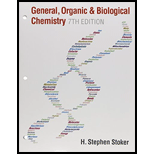
Concept explainers
(a)
Interpretation:
The term absolute alcohol means what has to be given.
Concept Introduction:
Alcohols are commonly encountered in our day-to-day life. Some of the commonly encountered alcohols are, methanol, ethanol, propanol, ethylene glycol, propylene glycol, glycerol.
(b)
Interpretation:
The term grain alcohol means what has to be given.
Concept Introduction:
Alcohols are commonly encountered in our day-to-day life. Some of the commonly encountered alcohols are, methanol, ethanol, propanol, ethylene glycol, propylene glycol, glycerol.
(c)
Interpretation:
The term rubbing alcohol means what has to be given.
Concept Introduction:
Alcohols are commonly encountered in our day-to-day life. Some of the commonly encountered alcohols are, methanol, ethanol, propanol, ethylene glycol, propylene glycol, glycerol.
(d)
Interpretation:
The term drinking alcohol means what has to be given.
Concept Introduction:
Alcohols are commonly encountered in our day-to-day life. Some of the commonly encountered alcohols are, methanol, ethanol, propanol, ethylene glycol, propylene glycol, glycerol.
Want to see the full answer?
Check out a sample textbook solution
Chapter 14 Solutions
Bundle: General, Organic, and Biological Chemistry, 7th + OWLv2 Quick Prep for General Chemistry, 4 terms (24 months) Printed Access Card
- A. List the five tests from your lab report and answer positive or negative for the following compound. B. What visible change would you see in a positive test? ОН OH H. OH ОНarrow_forwardA. List the five tests from your lab report and answer positive or negative for the following compound. B. What visible change would you see in a positive test? CH2OH CH2OH HO, HO, OH OH OHarrow_forwardWhat are the relative dangers of wrong and unapproved mixtures and combinations of alcoholic substances and how can these dangers be averted?arrow_forward
- This product contains 8 mg of iron which reflects 45% of daily value of iron. The daily value of iron is equal to O 18 mg O 22 mg O 30 mg 50 mgarrow_forwardA doctor prescribes an ointment that is 2% hydrocortisone. A pharmacist has 1% and 5% concentrations in stock. How many ounces of each should the pharmacist use to make a 1-ounce tube?arrow_forwardyou've just consumed 3 12-ounce ales with 8% alcohol. How much alcohol have you consumed?arrow_forward
- 3) Which of the following corresponds to a standard drink of alcohol? A) 12 ounces of beer B) 12 ounces of wine C) 5 ounces of vodka D) 5 ounces of beerarrow_forwardIndicate what you would do and the observations you would expect for each case. Be explicit in your explanations . Use simple chemical tests ( not including melting point, boiling point, spectroscopy, etc.) whenever possible and more elaborate tests for other cases. Describe how to distinguish between each of the following: A. 1-phenylpropyne and 3-phenylpropyne B. phenol and p-hydroxybenzyl alcoholarrow_forwardIf the dehydration reaction of an alcohol is successful, what changes would be seen in the IR spectrum for the product compared to the starting materialarrow_forward
- A prescription asked for a 500 mL 12% dextrose solution. How would you prepare the prescription if the available dextrose solutions in the pharmacy are 10% and 20%?arrow_forwardSodas typically contain sugar, flavorings, coloring agents, and carbon dioxide dissolved in water. The best term to describe this mixture would be _____.arrow_forwardYou are preparing to give your patient 3mg of Ondansetron. Ondansetron comes packaged as 2mg/mL. How many mL of Ondansetron will you administer?arrow_forward
- Essentials of Pharmacology for Health ProfessionsNursingISBN:9781305441620Author:WOODROWPublisher:Cengage



